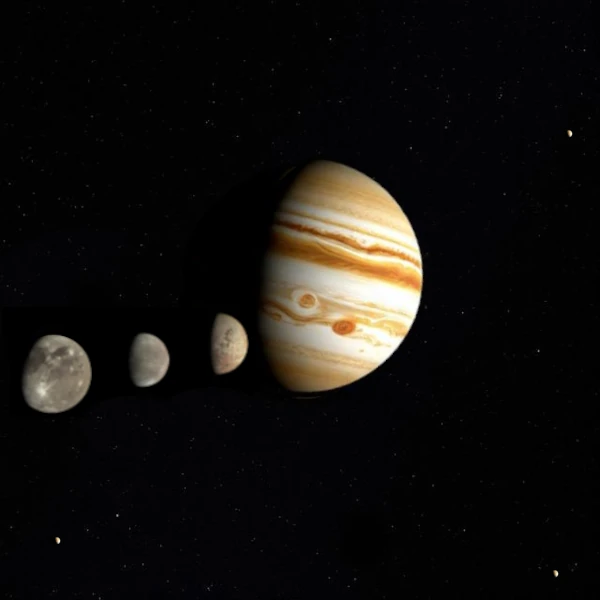
With its 95 confirmed moons as of 2025, including 4 discovered by Galileo (1564-1642) in 1610, Jupiter forms a true miniature planetary system. This gas giant, 318 times more massive than Earth, exerts such a powerful gravitational influence that it captures passing asteroids and comets. The Jovian system is a family of satellites with characteristics as varied as the planets of the solar system. The JUICE (ESA) and Juno (NASA) missions now reveal ocean worlds, active volcanoes, and complex atmospheres, providing an ideal study ground for exobiology and comparative planetology.
| Satellite | Diameter (km) | Distance from Jupiter (103 km) | Orbital period (days) | Notable features | Type/Group |
|---|---|---|---|---|---|
| Ganymede | 5,262.4 ± 0.2 | 1,070.4 | 7.1546 | Largest moon in the solar system. Own magnetic field (0.718 μT). Salty ocean between two ice layers (estimated depth: 100 km). Mixed surface of bright and dark terrains. | Regular (Galilean) |
| Callisto | 4,820.6 ± 0.2 | 1,882.7 | 16.6890 | Most cratered surface in the solar system. Valhalla crater (3,800 km in diameter). Possible subsurface ocean at 150 km depth. Albedo: 0.22. | Regular (Galilean) |
| Io | 3,643.2 ± 0.3 | 421.8 | 1.7691 | Most volcanically active body in the solar system (> 400 active volcanoes). Composition: silicate and sulfur compounds. Max temp: 2,000 K. Over 100 mountains (some taller than Everest). | Regular (Galilean) |
| Europa | 3,121.6 ± 0.2 | 671.1 | 3.5512 | Global subsurface ocean (100 ± 20 km deep). Young surface (30-80 Ma) with ice fractures. High albedo: 0.67. Tidal pressures generating internal heat. | Regular (Galilean) |
| Amalthea | 166.7 × 98.3 × 93.6 | 181.37 | 0.4982 | Elongated shape. Reddish surface (sulfur deposits ejected by Io). Surface temp: 110 ± 10 K. Giant craters (Pan, Gaea) relative to its size. | Regular (Amalthea group) |
| Himalia | 85 ± 5 | 11,460 | 250.56 | Largest member of the Himalia group. Prograde irregular orbit. Composition similar to C-type asteroids. Discovered in 1904 by Perrine. | Irregular (Himalia group) |
| Elara | 80 ± 5 | 11,740 | 259.64 | Second-largest moon in the Himalia group. Albedo: 0.04. Rotation period: ~12h. Possible captured object from the asteroid belt. | Irregular (Himalia group) |
| Thebe | 98.6 × 97.6 × 82.6 | 221.89 | 0.6745 | Zethus crater (40 km in diameter, ~40% of the moon's diameter). Contributes to the outer gossamer ring. Markedly irregular shape. | Regular (Amalthea group) |
| Pasiphae | 58 ± 2 | 23,620 | 743.63 | Largest retrograde moon. Highly inclined orbit (151.4°). Composition: likely a captured asteroid. Family of 17 irregular moons. | Irregular (Pasiphae group) |
| Metis | 43 ± 2 | 127.96 | 0.2948 | Innermost moon. Orbits in 7h05m. Main source of Jupiter's main ring. Surface covered in deep impact craters. | Regular (Amalthea group) |
| Adrastea | 16.4 × 14.0 × 12.0 | 128.98 | 0.2983 | Smallest moon in the Jovian system. Irregular shape. Orbits at the outer edge of the main ring. Discovered by Voyager 2 images. | Regular (Amalthea group) |
| Carpo | 3 ± 0.5 | 17,150 | 458.62 | Prograde orbit inclined at 51°. Possible collision fragment. Discovered in 2003. Absolute magnitude: 16.9. | Irregular (isolated) |
| S/2003 J 2 | 2 ± 0.5 | 28,570 | 982.5 | Extreme irregular moon. Highly eccentric orbit (e=0.38). Belongs to the Pasiphae group. Rotation period unknown. | Irregular (Pasiphae group) |
| Valetudo | 1.0 ± 0.3 | 19,000 | 533.3 | "Suicidal" orbit crossing retrograde moons. High future collision risk. Named after the Roman goddess of health. | Irregular (isolated) |
| S/2018 J 2 | 1.5 ± 0.3 | 23,550 | 722.3 | Discovered in 2018. Belongs to the Pasiphae group. One of the smallest known moons of Jupiter. Retrograde orbit. | Irregular (Pasiphae group) |
Sources: NASA Solar System Exploration (October 2025); JPL Small-Body Database; Scott S. Sheppard (2025), Jupiter's Moons: A Comprehensive Review, Annual Review of Astronomy and Astrophysics; Data from HST and VLT/ESO (2024).
Three major missions will revolutionize our understanding of the Jovian system by 2035:
As astrophysicist Michel Blanc (1954-) from IRAP notes: "Exploring Jupiter and its moons is like traveling back in time to observe the conditions of the early solar system while preparing for the study of exoplanetary systems."
Hot Jupiters (giant exoplanets close to their star) could host similar moon systems. Simulations by Nikku Madhusudhan (1981-) (University of Cambridge) suggest that up to 27% of these planets could have habitable moons in the CHZ. The JWST detected potential moon signatures around Kepler-1625b in 2024, 8,000 light-years away.
The Jovian system reminds us that the search for life is not limited to planets: moons, with their hidden oceans and internal energy sources, could be the most likely cradles for extraterrestrial life in our galaxy.